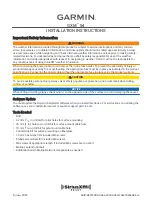NXP Semiconductors
AN11740
PN5180 Antenna design
AN11740
All information provided in this document is subject to legal disclaimers.
© NXP B.V. 2018. All rights reserved.
Application note
COMPANY PUBLIC
Rev. 1.1 — 19 June 2018
345311
44 of 62
4.4 Optimizing the transmitting
The optimum register settings might be different from the default values stored in the
EEPROM. So, for the optimization and testing typically the registers can be tuned and
changed directly. As soon as the optimum settings are derived, the new settings might be
changed and stored in the corresponding EEPROM area for the LOAD_RF_CONFIG.
Then in the final application simply the standard LOAD_RF_CONFIG command can be
used again with the optimized settings, and no modification of the application sw is
required.
The NFC Cockpit (GUI) supports this optimization procedure, refer to [9] for details
regarding the evaluation board and the use of the GUI.
In a typical PCD design the output stage of the PN5180 is used with the maximum
available output power, and the overall power consumption (and field distribution) is
limited with the antenna impedance.
The standard modulation of the Tx signal is either a 100% AM for type A or a 10% AM for
type B. The modulation index for type B must be adjusted due to the antenna tuning with
the TX_RESIDUAL_CARRIER in the RF_CONTROL_TX register.
On top it might be helpful to adapt the rise and fall times of the Tx envelop signal to
match the pulse shapes to the timing requirements of the according standard (NFC, ISO
or EMVCo). However, these shaping settings typically make sense only in combination
with the DPC antenna design and the DPC itself.
The default settings in the EEPROM are optimized for the PN5180 based on the 65mm x
65mm evaluation board antenna. Some of these settings typically must be adjusted and
optimized for other antenna designs.
The major parameters for the Tx are:
3. Modulation index e.g. for type B (TX_RESIDUAL_CARRIER)
4. TX_Clockmode in combination with Tx shaping (TX_CLK_MODE_RM)
5. Tx Shaping, overshoot prevention, rise and fall time, if needed
Note:
The main benefits of the PCD TX shaping are related to the DPC antenna
design. A more detailed description of the PCD TX shaping related to the
symmetrical antenna tuning and the DPC can be found in [14] and [15].
4.4.1 Modulation pulse width
The modulation pulse width is automatically set with the LOADPROTOCOL. No
optimization is needed.
4.4.2 Type B Modulation index
For type B the modulation index needs to be checked and maybe adjusted, since the
final optimum setting depends on the antenna design. The LOAD_RF_CONFIG provides
the correct settings, which are required for type B, but the modulation index must be set
with TX_RESIDUAL_CARRIER in the RF_CONTROL_TX register, as described in detail
in [1].


















